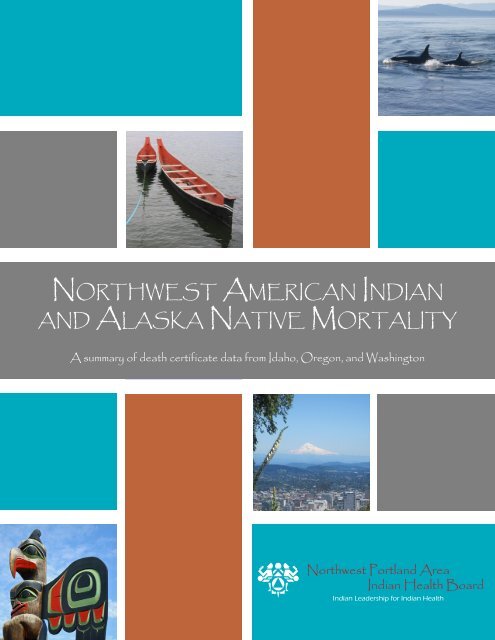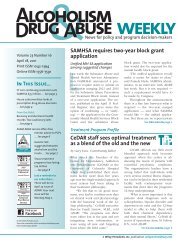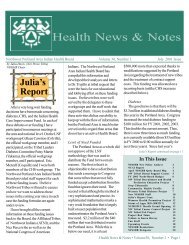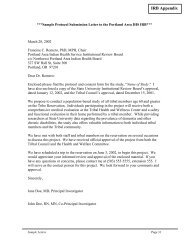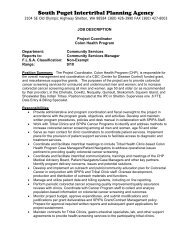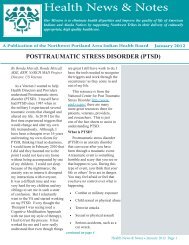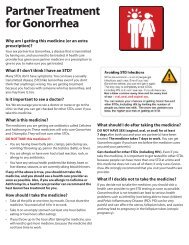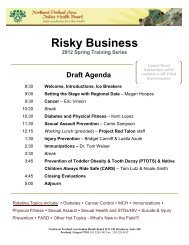Northwest American Indian and Alaska Native Mortality (2012) 7.7mb
Northwest American Indian and Alaska Native Mortality (2012) 7.7mb
Northwest American Indian and Alaska Native Mortality (2012) 7.7mb
You also want an ePaper? Increase the reach of your titles
YUMPU automatically turns print PDFs into web optimized ePapers that Google loves.
Contents6Background8Methods9Linkage Results10Leading Causes of Death12Unintentional Injuries15Motor Vehicle Crashes19Accidental Poisonings24Falls25Accidental Drownings27Suicide31Homicide33Conclusions <strong>and</strong> Summary of Key FindingsImproving Data & Enhancing Access (IDEA-NW)5
Linkage ResultsIdahoBetween 2006 <strong>and</strong> 2010, there were 708 AI/AN deaths <strong>and</strong> 52,925white deaths among Idaho residents. These numbers reflect thecorrection for racial misclassification. During the linkage it wasdetermined that 59 AI/AN deaths were misclassified as anotherrace (most commonly white). The misclassification prevalenceamong all AI/AN records was 8%. Linkage with the NTRincreased ascertainment of AI/AN deaths by about 9%. Amongrecords for which a race had been coded in Idaho, 92% wereclassified correctly as AI/AN.OregonBetween 2006 <strong>and</strong> 2010, there were 2,017 AI/AN deaths <strong>and</strong> 145,971 white deaths among Oregon residents.These numbers reflect the correction for racial misclassification. During the linkage it was determinedthat 261 AI/AN deaths were misclassified as non-AI/AN (about 98% of these were coded as white).The misclassification prevalence among all AI/AN records was 13%. Linkage with the NTR increasedascertainment of AI/AN deaths by 15%. Among records for which a race had been coded in Oregon, 77%were classified correctly as AI/AN.WashingtonBetween 1990 <strong>and</strong> 2009, there were 12,780 AI/AN deaths <strong>and</strong> 797,555 white deaths among Washingtonresidents. These numbers reflect the correction for racial misclassification. During the linkage it wasdetermined that 1,242 AI/AN deaths were misclassified as another race (usually white). The misclassificationprevalence among all AI/AN records was 10%. Linkage with the NTR increased ascertainment of AI/ANdeaths by about 11%. Among records for which a race had been coded, 84% were classified correctly asAI/AN in the state data system.…◀Improving Data & Enhancing Access (IDEA-NW)9
Leading Causes of DeathTable 1 presents the top ten causes of death for all three <strong>Northwest</strong> statescombined. Both AI/ANs <strong>and</strong> whites shared the same top two causesof death, heart disease <strong>and</strong> cancer. However, these leading two causesaccounted for a larger proportion of deaths among whites (54%) thanAI/ANs (42%). Unintentional injury was the third leading cause forAI/ANs, accounting for proportionally over twice as many deaths asamong whites. Diabetes <strong>and</strong> chronic liver disease were the fourth <strong>and</strong> sixthleading causes of death respectively for AI/ANs, but did not appear in thetop five for whites. Alzheimer’s Disease was the fifth leading cause of deathfor whites but was only the eighth most common cause for AI/ANs (tiedwith influenza <strong>and</strong> pneumonia).Throughout the four year period, all-cause mortality rates forAI/ANs ranged from 1.2 times that of whites (in Idaho) to 1.6 times (inWashington).Unintentional injury <strong>and</strong> chronic liver disease were notable for evenhigher disparities (as high as 2.1 <strong>and</strong> 4.0 times the white rates respectively).Age-adjusted rates of the top ten causes of death among all <strong>Northwest</strong>AI/ANs <strong>and</strong> whites are presented in Figure 1.Table 1. Leading causes of death, <strong>Northwest</strong> states, 2006-2009Percent of All DeathsAI/ANWhite1 Heart Diseases (23.3%) Heart Diseases (30.1%)2 Cancer (19.1%) Cancer (23.8%)3 Unintentional Injury (11.4%) Chronic Lower Respiratory Disease (6.2%)4 Diabetes (5.1%) - tied Unintentional Injury (5.3%)5 Chronic Lower Respiratory Disease (5.1%) - tied Alzheimer’s Disease (5.1%)6 Chronic Liver Disease <strong>and</strong> Cirrhosis (4.9%) Diabetes (3.2%)7 Suicide (3.1%) Suicide (1.9%)8 Alzheimer’s Disease (1.9%) Influenza <strong>and</strong> Pneumonia (1.7%)9 Influenza <strong>and</strong> Pneumonia (1.8%) Chronic Liver Disease <strong>and</strong> Cirrhosis (1.4%)10 Homicide (1.4%) Parkinson’s Disease (1.1%)10 Improving Data & Enhancing Access (IDEA-NW)
Unintentional InjuriesDeaths due to injuries, both intentional <strong>and</strong> unintentional, reveal majordisparities. This is an area where prevention efforts may be particularlyeffective. In recent years, there has been an increasing public health focuson injury prevention in <strong>Indian</strong> Country. Unintentional injuries accountedfor the majority of injury deaths in <strong>Northwest</strong> AI/ANs, followed bysuicides <strong>and</strong> homicides.Unintentional InjuriesAI/ANs living in Washington had the highest rates of unintentional injurydeaths, followed by Idaho <strong>and</strong> Oregon. When compared with the whitepopulation, Washington also had the largest disparity with a rate ratio of2.4 (Figure 2).Age‐Adjusted Rate per 100,000Figure 2. Unintentional injury mortality, 2006-20091201008095.9AI/ANWhite67.063.7604042.0 37.7 40.3200Idaho Oregon WashingtonFocus on Community ProgramsNPAIHB’s Injury Prevention Program (IPP) has beenfunded through a cooperative agreement with the <strong>Indian</strong>Health Service (IHS) since 2010. The IPP oversees the<strong>Northwest</strong> Tribal Injury Prevention Coalition, whichrecently developed a 5-year Tribal Injury PreventionAction Plan. Together, the IPP <strong>and</strong> Coalition memberswork with the <strong>Northwest</strong> Tribes to develop <strong>and</strong> implementeffective injury prevention <strong>and</strong> education strategies,with an emphasis on motor vehicle safety <strong>and</strong> elder fallsprevention. The IPP also contributes to the collection,analysis <strong>and</strong> interpretation of injury data.For more information about NPAIHB’sInjury Prevention work, contact:Luella Azule (Yakama/Umatilla),Injury Prevention Program Coordinator,lazule@npaihb.org,503-416-3263.12 Improving Data & Enhancing Access (IDEA-NW)
Men had higher rates of unintentional injury deaths across all three states, <strong>and</strong> for AI/ANs the difference waslargest in Idaho, where men were twice as likely to die from unintentional injuries than women (Figure 3).The majority of unintentional injury deaths among both racial groups were attributable to motor vehiclecrashes (MVC) <strong>and</strong> accidental poisoning, although MVCs accounted for proportionally more deaths amongAI/ANs than whites (Figure 4). Whites had a much higher proportion of unintentional injury deaths dueto falls than AI/ANs. This is possibly related to the difference in age at death as we find AI/ANs are dying atyounger ages of other causes while most fall deaths among whites occur in those eighty years <strong>and</strong> older.Figure 3. Unintentional injury mortality by sex, 2006-2009140AI/AN MaleAge-Adjusted Rate per 100,0001201008060402074.6 73.955.451.337.428.9118.8AI/AN FemaleWhite MaleWhite Female74.253.850.425.8 27.70Idaho Oregon Washington50%Figure 4. Leading causes of unintentional injury deaths,<strong>Northwest</strong> states, 2006-200940%39%33%AI/ANWhite30%26% 26% 28%20%17%14%10%8%4%3%0%MotorVehicleCrashesAccidentalPoisoningFallsAccidentalDrowningOtherImproving Data & Enhancing Access (IDEA-NW)13
The age distribution for unintentional injury deaths differed between the two racial groups, with AI/ANsbetween the ages of 15 <strong>and</strong> 29 at especially high risk when compared with whites. At all points throughout theage distribution, AI/ANs had higher rates, with the exception of those ages 80 <strong>and</strong> older (Figure 5).In Washington, wheredata were available backto 1990, trend analysisreveals that unintentionalinjury mortality rates wereconsistently higher for AI/ANs than whites during thistime period, averaging overtwo times higher (Figure 6).AI/AN males <strong>and</strong> femalesboth experienced similartrends, with male rates abovefemales, but female AI/ANrates increased more rapidly.Overall, both AI/AN <strong>and</strong>white unintentional injurymortality rates increasedsignificantly over the timeperiod, with an annualpercent change (APC) of1.7% for AI/ANs <strong>and</strong> 1.4%for whites (Figure 6).Age-Adjusted Rate per 100,000120100806040200Age‐specific rate per 100,000Figure 5. Unintentional injury mortality by age, 2006-200935030025020015010050‐0‐910‐1920‐29Figure 6. Unintentional injury mortality rates,Washington, 1990-2009, 3-year rolling averagesAI/AN30‐39WhiteAI/AN40‐49APC = +1.7%APC = +1.4%White50‐5960‐6970‐7980+Note on trend dataNote that cause ofdeath coding on deathcertificates underwent achange from ICD-9 toICD-10 between 1998 <strong>and</strong>1999. Data shown in thetrends charts in this reporthave not been adjustedto reflect this change,however the blue shadedarea highlights where thechange occurred.Comparability ratiosfor the broad categoriesreported here show thatthe change did not havea large impact for thesestatistics, however anyabrupt changes between1998 <strong>and</strong> 1999 should beinterpreted with caution.14 Improving Data & Enhancing Access (IDEA-NW)…◀
Unintentional Injuries: Motor Vehicle CrashesMotor vehicle crashes were the largest contributor to AI/ANunintentional injury deaths, <strong>and</strong> across all three states rates were anaverage of 2.5 times higher for AI/ANs than whites. Idaho had thehighest rates of MVC deaths for AI/ANs, while Washington showedthe largest disparity (Figure 7).Figure 7. Motor vehicle crash mortality, 2006-2009Age‐Adjusted Rate per 100,00040353025201510534.516.120.910.632.89.4AI/ANWhite0Idaho Oregon WashingtonImproving Data & Enhancing Access (IDEA-NW)15
Again, males were at higher risk for MVC deaths than females (Figure 8). Rates were considerably higher forAI/ANs across all age groups, with the largest disparity among ages 10-29. AI/AN children of car seat age, 0-9years old, experienced MVC mortality rates at about two <strong>and</strong> a half times those of whites (Figure 9).Figure 8. Motor vehicle crash mortality by sex, 2006-2009Age‐Adjusted Rate per 100,00045403530252015105040.140.6 AI/AN MaleAI/AN Female28.9White Male24.125.0White Female22.417.415.2 13.99.86.24.9Idaho Oregon WashingtonFigure 9. Motor vehicle crash mortality by age, 2006-2009Age‐specific rate per 100,00070605040302010‐AI/ANWhite0‐910‐1920‐2930‐3940‐4950‐5960‐6970‐7980+16 Improving Data & Enhancing Access (IDEA-NW)
Overall, MVC mortality washigher in non-metropolitanareas compared withmetropolitan counties 6 , whichis consistent with nationaldata 7 . AI/ANs driving inrural parts of Washingtonwere the most at risk. Thedisparity between urban <strong>and</strong>rural MVC deaths was mostpronounced for AI/ANsliving in Oregon, whereAI/ANs driving in rural areaswere more than twice as likelyto experience a fatal crash(Figure 10).Age‐Adjusted rate per 100,000040302010032.2Figure 10. Motor vehicle crash mortality bymetro/non-metro counties, 2006-200927.216.812.434.015.317.69.033.529.513.4AI/AN White AI/AN White AI/AN WhiteIdaho Oregon Washington7.1Non‐metroMetroFocus on Community ProgramsNPAIHB's <strong>Native</strong> Children Always Ride Safe(<strong>Native</strong> CARS) study is a collaboration betweensix <strong>Northwest</strong> Tribes, the NPAIHB <strong>and</strong> theUniversity of Washington’s Harborview InjuryPrevention <strong>and</strong> Research Center, funded by theNational Institute on Minority Health <strong>and</strong> HealthDisparities. The goal of the <strong>Native</strong> CARS study isto design, implement <strong>and</strong> test the effectiveness oftribal interventions to improve the use of childsafety seats among AI/AN children. Workingin partnership with Tribes <strong>and</strong> using tribal data,<strong>Native</strong> CARS seeks to determine the barriers to<strong>and</strong> facilitators of proper <strong>and</strong> consistent childsafety seat use. This information is then used bythe study partnership to design community levelintervention programs. The evaluation of theseintervention programs utilizes child safety seatuse data collected at baseline <strong>and</strong> following theintervention period.For more information please contactTam Lutz, <strong>Native</strong> CARS Project Director at503 416 3271 or tlutz@npaihb.orgnativecars@npaihb.org.View our web page at:http://www.npaihb.org/epicenter/project/native_cars_study6 By county of occurrence, defined by NCHS urban rural classification scheme http://www.cdc.gov/nchs/data_access/urban_rural.htm7 National Highway Traffic Safety Administration. Traffic safety facts, 2009 data: rural/urban comparison. Washington, DC: USDepartment of Transportation, National Highway Traffic Safety Administration; 2011. Publication no. DOT-HS-811-395.Improving Data & Enhancing Access (IDEA-NW)17
Trend data from Washington revealed rates of MVC deaths among AI/ANs which were, on average, about threetimes higher than whites. This disparity increased throughout the time period as whites experienced a significantdecrease in MVC mortality (APC=-2.6%) while AI/AN rates did not change significantly (Figure 11). Thissuggests that there may be some effective public health interventions in motor vehicle safety that have impactedthe white population but have not yet made it to the AI/AN population.Contributing factors suggested by tribal members may include rural roads, distance from hospitals <strong>and</strong> timespent in the car. Drawing on the multiple contributing causes of death, we also found that AI/AN MVC deathswere more likely to have alcohol as a contributing factor 8 than white MVC deaths. Across all three states, abouteight percent of AI/AN MVC deaths were associated with alcohol compared to five percent of white MVCdeaths. It should be noted that these percentages are lower than those found from other sources such as the FatalAccident Reporting System (FARS), which are probably more reliable in estimating alcohol impairment duringfatal crashes than the death certificate coding. A National Highway Traffic Safety Administration report usingFARS data from 1999-2004 estimated as many as 57% of AI/AN drivers killed in MVCs had blood alcohol levelsover 0.08%, compared with about a third of non-Hispanic white drivers 9 . Using the death certificate data again,we did find that trend data in Washington showed a strong decreasing trend in alcohol associated MVC deathsfor AI/ANs since 1990, along with a decrease in the race disparity.Other potential explanations for the MVC death rate disparity seen here include lower seat belt <strong>and</strong> child safetyseat use <strong>and</strong> more speeding among AI/ANs 10,11 .Figure 11. Motor vehicle crash mortality by race, Washington, 1990-2009,3-year rolling averages50AI/ANWhiteAge-Adjusted Rate per 100,000403020100APC = -2.6%8 Underlying COD of MVC <strong>and</strong> at least one contributing COD of alcohol induced; see Table 3 for ICD codes.9 Department of Transportation (US), National Highway Traffic Safety Administration (NHTSA). Race <strong>and</strong> Ethnicity in Fatal Motor Vehicle TrafficCrashes, 1999-2004. May 2006. DOT HS 809 956.10 Department of Transportation (US), National Highway Traffic Safety Administration (NHTSA). Fatal Motor Vehicle Crashes on <strong>Indian</strong>Reservations, 1975-2002. April 2004. DOT HS 809 727.11 Lapidus JA, Smith NH, Ebel BE, Romero FC. Restraint use among northwest <strong>American</strong> <strong>Indian</strong> children traveling in motor vehicles. Am J PublicHealth. 2005 Nov;95(11):1982-8. Epub 2005 Sep 29.18 Improving Data & Enhancing Access (IDEA-NW)…◀
Unintentional Injuries: Accidental PoisoningsAccidental poisoning was the second leading cause of AI/ANunintentional injury deaths after motor vehicle crashes. By farthe leading contributor to poisoning deaths was accidental drug<strong>and</strong> alcohol overdoses. Poisonings due to substances such as gas<strong>and</strong> vapors, pesticides, household chemicals, <strong>and</strong> other noxioussubstances made up less than 2% of poisoning deaths in bothAI/ANs <strong>and</strong> whites <strong>and</strong> thus are not included in the followinggraphs.Accidental drug <strong>and</strong> alcohol overdose deaths varied widely acrossthe region, with rates for AI/ANs in Washington more than fourtimes those in Idaho (Figure 12). Across all three states, though,AI/AN rates were higher than whites.Figure 12. Accidental drug <strong>and</strong> alcohol overdose mortality, 2006-2009Age‐Adjusted Rate per 100,0004035302520151058.06.815.99.133.811.9AI/ANWhite0Idaho Oregon WashingtonImproving Data & Enhancing Access (IDEA-NW)19
In Idaho, accidental drug <strong>and</strong> alcohol mortality rates for men <strong>and</strong> women were nearly the same, while the othertwo states saw male rates outpacing females (Figure 13).Both races showed asimilar pattern across theage distribution, with apeak for accidental drug<strong>and</strong> alcohol overdosemortality occurringat middle age (Figure14). AI/AN rates forthe younger age groupswere notably higher thanwhites in the same ageranges. AI/AN youth(10-19 years) died fromaccidental drug <strong>and</strong>alcohol exposure at ratesmore than four timeshigher than white youth.Age‐Adjusted Rate per 100,000Figure 13. Accidental drug <strong>and</strong> alcohol overdose mortality by sex,2006-2009504030201006.716.715.011.89.27.56.0 6.438.728.914.39.4Idaho Oregon WashingtonAI/AN MaleAI/AN FemaleWhite MaleWhite FemaleFigure 14. Accidental drug <strong>and</strong> alcohol overdose mortality by age,2006-200960AI/AN White50Age‐specific rate per 100,00040302010‐0‐910‐1920‐2930‐3940‐4950‐5960‐6970‐7980+20 Improving Data & Enhancing Access (IDEA-NW)
Washington trend data showed that, since 1994, AI/AN rates ofdrug overdose deaths were higher than whites, <strong>and</strong> increasingmore quickly (Figure 15). While both populations had a significantincrease in drug overdose deaths over this time period, AI/ANrates increased an average of 14.6% per year compared with anannual increase of 10.7% for whites.Since 1999, prescription drugs have outpaced illicit drugs as themost common type of drug overdose. Whites <strong>and</strong> AI/ANs haveboth seen steep increases in prescription drug overdose deaths,but AI/AN rates have increased at almost twice the pace (APC =16.2% versus 8.7% for Whites). Most worrisome are deaths due toprescription opioid pain relievers (OPR), from which WashingtonAI/ANs have seen a 22% increase annually since 1999.Table 3 summarizes the types of drug overdose deaths from eachstate, including both deaths with underlying cause of drug oralcohol, <strong>and</strong> those with contributing cause of drug or alcohol. For example, a death with an underlying cause ofmotor vehicle crash may have had alcohol as a contributing factor - this would be included in the row "alcoholassociated deaths". Note that "drug associated" <strong>and</strong> "alcohol associated" include deaths from both short term <strong>and</strong>long term substance use, but exclude drug deaths that are not related to substance abuse such as medical errorsor allergic reactions.Age-Adjusted Rate per 100,00035302520151050Figure 15. Accidental drug overdose mortality, Washington, 1990-20093-year rolling averagesAI/ANWhiteAPC = +14.6%APC = +10.7%Improving Data & Enhancing Access (IDEA-NW)21
Focus on Community ProgramsNPAIHB’s THRIVE project (Tribal Health: Reaching OutInVolves Everyone) is also working with the <strong>Northwest</strong> Tribesto prevent drug <strong>and</strong> alcohol abuse. In 2010 the project hostedmeetings with regional partners to develop a 5-year strategicplan: <strong>Northwest</strong> Tribal Substance Abuse Action Plan. The plan isnow being used to guide program planning, catalyze communityoutreach efforts, <strong>and</strong> foster a coordinated response to substanceabuse in our <strong>Northwest</strong> Tribes.Acting upon one of the goals of the plan - to “increase knowledge<strong>and</strong> awareness about substance abuse”- the THRIVE projectdeveloped a national media campaign focusing on Alcohol <strong>and</strong>Drug prevention for AI/AN teens <strong>and</strong> young adults. The campaign,Strengthen My Nation, was funded by the <strong>Indian</strong> Health Service’sMeth & Suicide Prevention Initiative, <strong>and</strong> was developed withfeedback from hundreds of teens, parents, <strong>and</strong> health educatorsfrom throughout the U.S. The campaign includes posters,brochures, fact sheets, <strong>and</strong> public service announcements ontelevision <strong>and</strong> radio. All of the campaign materials are available onthe NPAIHB website: http://www.npaihb.org/epicenter/project/mspi_prevention_media_resources/…◀Improving Data & Enhancing Access (IDEA-NW)23
Unintentional Injuries: FallsWhile rates of death due to falls were lower than the other causes of unintentional injury examined thus far,among AI/AN elders (60 years <strong>and</strong> older), falls were the leading cause of injury deaths. Data from Californiashow that AI/AN elders fall more than any other racial/ethnic group, <strong>and</strong> that those ages 55-64 are at high riskeven though elder programs often focus on individuals over age 65 12 .In the <strong>Northwest</strong>, there was not a large disparity seen between AI/ANs <strong>and</strong> whites in mortality due to falls,although AI/AN rates were marginally higher (12.5 vs. 10.4 per 100,000). Males were at slightly higher risk thanfemales in each of the three states.Figure 16. Accidental fall mortality by age,<strong>Northwest</strong> states, 2006-2009250AI/ANWhite20015010050‐0‐4950‐5960‐6970‐7980+Age‐specific rate per 100,000The rates of mortality due to falls rose dramatically forAI/ANs over the age of 70, while they were very low amongthose younger than 70 (Figure 16). AI/ANs who diedfrom falls were about seven years younger than their whitecounterparts in Oregon <strong>and</strong> Washington. In Idaho the meanage at death was slightly older, but this was based on a verysmall number of cases <strong>and</strong> so should be interpreted withcaution (Table 4).Table 4. Age at death due to falls, 2006-2009AI/ANWhiteMean Median Mean MedianIdaho 82.8 88 78.6 84Oregon 66.1 71 82.0 86Washington 69.9 74 79.7 8412 Satter DE, Wallace SP, Garcia AN, Smith LM. Health of <strong>American</strong> <strong>Indian</strong> <strong>and</strong> <strong>Alaska</strong> <strong>Native</strong> Elders in California. Los Angeles, CA:UCLA Center for Health Policy Research, 2010.24 Improving Data & Enhancing Access (IDEA-NW)
Unintentional Injuries: Accidental DrowningAccidental drowning rates were low compared to other causesof unintentional injury. On average in the <strong>Northwest</strong>, there wereabout 14 drowning deaths per year among AI/ANs (55 deaths from2006-2009). Overall, the accidental drowning rate for <strong>Northwest</strong>AI/ANs was slightly less than 2 per 100,000, but this variedbetween the states (Figure 17).During this time period in Idaho there were no AI/AN accidentaldrowning deaths reported. The highest rate was seen inWashington at 4.1 per 100,000, which was 3.2 times the rate for thewhite population.5Figure 17. Accidental drowning mortality, 2006-2009Age‐Adjusted Rate per 100,00043211.4 1.4 1.54.11.3AI/ANWhite0Idaho Oregon WashingtonImproving Data & Enhancing Access (IDEA-NW)25
Young adult AI/ANs aged 20-29 had the highest rates of accidental drowning, with another smaller peakoccurring among those ages 40-49 (Figure 18). AI/AN children under age ten were also at risk, with rates morethan 60% higher than whites among children in this age range. Due to small numbers, however, these agespecificrates are unstable <strong>and</strong> should be interpreted with caution.Age‐specific rate per 100,000654321‐Figure 18. Accidental drowning mortality by age, 2006-2009AI/AN White0‐910‐1920‐2930‐3940‐4950‐5960‐6970‐7980+Drowning rates inWashington appearto have decreased forAI/ANs over the past20 years, althoughthe trend was notstatistically significant(Figure 19). Rates forthe white populationdecreased at a small butstatistically significantrate of 1.3% per year.Age-Adjusted Rate per 100,000Figure 19. Accidental drowning mortality, Washington, 1990-2009,3-year rolling averages76543210AI/ANWhiteAPC = -1.3%26 Improving Data & Enhancing Access (IDEA-NW)…◀
Intentional Injuries: SuicideSuicides accounted for about one-fifth of all AI/AN injury deathsin the region. Idaho had the highest rates of AI/AN suicide at 27per 100,000 while Oregon had the lowest at 16 per 100,000 (Figure20). AI/AN rates were 60-70% higher than rates for whites in bothIdaho <strong>and</strong> Washington, but in Oregon there was little differencebetween the races.Figure 20. Suicide mortality, 2006-2009Age‐Adjusted Rate per 100,0003025201510526.616.715.815.022.513.2AI/ANWhite0Idaho Oregon WashingtonImproving Data & Enhancing Access (IDEA-NW)27
Male AI/ANs were much more likely to die of suicide than females; the largest difference was seen in Idahowhere male AI/AN suicide rates were more than four times higher than females (Figure 21). While the rates ofcompleted suicides are much higher for males, it should be noted that several studies have found that females aremore likely to attempt suicide than males. 13,14Figure 21. Suicide mortality by sex, 2006-2009Age-Adjusted Rate per 100,000504030201042.410.427.123.6 23.88.96.6 6.934.021.311.55.6AI/AN MaleAI/AN FemaleWhite MaleWhite Female0Idaho Oregon WashingtonFigure 22. Suicide mortality by age, 2006-2009While the majority ofAI/AN suicides occurredin the young adult range,20-39, the largest disparitybetween AI/ANs <strong>and</strong> whiteswas seen among youth. Ratesof suicide among AI/ANs10-19 years old were 3.3times higher than those seenamong white youth in thesame age range (Figure 22).Age‐specific rate per 100,000403530252015105‐AI/ANWhite0‐910‐1920‐2930‐3940‐4950‐5960‐6970‐7980+13 Dorgan BL. The Tragedy of <strong>Native</strong> <strong>American</strong> Youth Suicide. Psychological Services 2010;7(3):213-218.14 Alcantara C, Gone JP. Reviewing Suicide in <strong>Native</strong> <strong>American</strong> Communities: Situating Risk <strong>and</strong> Protective Factors within aTransactional-Ecological Framework. Death Studies 2007;31:457-477.28 Improving Data & Enhancing Access (IDEA-NW)
Nearly half of all AI/AN suicides were completed using firearms (Figure 23). Suffocation was the secondmost common mechanism (primarily hanging), <strong>and</strong> this method was more common among AI/ANs whilepoisoning (primarily drug overdose) was more common among whites. Among AI/ANs, the use of firearms<strong>and</strong> poisoning increased with age, while suffocation decreased (Figure 24).Figure 23. Suicide mechanism by race, <strong>Northwest</strong> states, 2006-2009Percent of all suicide deaths60%50%40%30%20%10%47%54%30%18% 20%15%8%8%AI/ANWhite0%Firearms Suffocation Poisoning OtherPercent of all suicide deathsFigure 24. Suicide mechanism by age, <strong>Northwest</strong> AI/ANs, 2006-2009100%90%16% Suffocation30%Poisoning80%43%24% Firearms70%Other60%18%50%40%30%20%10%0%4%45% 43% 58%9% 10%3%0‐24 25‐49 50+Age at DeathImproving Data & Enhancing Access (IDEA-NW)29
Washington trend data showed that suicide rates were rather stable over the twenty year period 1990-2009(Figure 25). Whites did experience a small but significant decrease in suicides (annual decrease of 0.5%) whileAI/AN suicide rates did not change significantly.Figure 25. Suicide mortality, Washington, 1990-20093-year rolling averages25AI/ANWhiteAge-Adjusted Rate per 100,00020151050APC = -0.5%Focus on Community ProgramsThe NPAIHB is working with the <strong>Northwest</strong>Tribes to prevent suicide. In 2008 it hostedmeetings with regional partners to develop a5-year strategic plan: <strong>Northwest</strong> Suicide TribalAction Plan. The plan helped the NPAIHB securefunding from the <strong>Indian</strong> Health Service’s Meth& Suicide Prevention Initiative – which helpedcreate the THRIVE project (Tribal Health:Reaching Out InVolves Everyone). Since then,the THRIVE project has provided training <strong>and</strong>technical assistance to the Northewest tribes onways to prevent suicide.To increase community awareness about theproblem, the project developed a suicide mediacampaign in 2010, <strong>and</strong> in 2011 it exp<strong>and</strong>ed thecampaign to focus on suicide <strong>and</strong> youth bullying.Both campaigns were funded by the <strong>Indian</strong>Health Service’s Meth & Suicide PreventionInitiative. The campaigns materials are availableon the NPAIHB website: http://www.npaihb.org/epicenter/project/mspi_prevention_media_resources/For more information:Colbie M. Caughlan, MPHSuicide Prevention ProjectManager - THRIVEPh. 503-416-3284ccaughlan@npaihb.org30 Improving Data & Enhancing Access (IDEA-NW)…◀
Intentional Injuries: HomicideHomicide rates among <strong>Northwest</strong> AI/ANs ranged from 3.6 timeshigher than whites in Washington to 3.3 times higher in Idaho(Figure 26). Washington AI/ANs had the highest homicide ratein the region at 9.5 per 100,000. Males were more likely to die dueto homicide in each state <strong>and</strong> among both race groups (Figure27). There were no AI/AN female homicides in Idaho in this timeperiod.Figure 26. Homicide mortality, 2006-2009Age‐Adjusted Rate per 100,0001086426.36.81.9 2.09.52.6AI/ANWhite0Idaho Oregon WashingtonAge‐Adjusted Rate per 100,00014121086420Figure 27. Homicide mortality by sex, 2006-200912.511.89.9AI/AN MaleAI/AN FemaleWhite Male7.1 White Female2.63.22.93.61.51.2 1.2Idaho Oregon WashingtonImproving Data & Enhancing Access (IDEA-NW)31
For both races, homicide rates peaked among the 20-29 year old age group (Figure 28). This age group alsoexperienced the greatest disparity, with AI/ANs at rates nearly five times higher than whites. Homicide ratesamong children under 20 were also strikingly higher compared to whites <strong>and</strong> while the number of deaths wassmall, there were about 3.5 times more homicides among AI/AN youth.Figure 28. Homicide mortality by age, 2006-2009Age‐specific rate per 100,0002015105AI/ANWhite‐0‐910‐1920‐2930‐3940‐4950‐5960‐6970‐7980+Both racial groups experienced a significant decrease in homicide mortality over time in Washington (Figure29). AI/AN rates dropped more quickly, an average 3.9% decrease per year, compared with whites (2.6% decreaseper year). Across the 20-year period, homicide rates were consistently higher for AI/AN men than AI/ANwomen, but decreased significantly for men (APC = -4.2%), so the gap between men <strong>and</strong> women was seen to beclosing in recent years (data not shown on chart).Figure 29. Homicide mortality, Washington, 1990-2009,3-year rolling averages20AI/ANWhiteAge-Adjusted Rate per 100,000151050APC = -3.9%APC = -2.6%32 Improving Data & Enhancing Access (IDEA-NW)…◀
Conclusions <strong>and</strong> Summary of Key Findings<strong>Mortality</strong> represents the tip of the iceberg of underlying healthconditions. Each death represents many more who are alive todaywith chronic depression, substance abuse disorders <strong>and</strong> chronicdisease. Moreover, deaths that affect disproportionately theyoungest community members have the greatest impact in termsof years of potential life lost. The information contained in thisreport focuses a spotlight on some of the most important causes ofmortality that impact AI/AN communities.These data can be used by tribes, states, community organizations,<strong>and</strong> policy makers to identify health needs in the community, setpriorities for action, <strong>and</strong> develop appropriate policies <strong>and</strong> services.LimitationsRace information for <strong>American</strong> <strong>Indian</strong>s <strong>and</strong> <strong>Alaska</strong> <strong>Native</strong>s is oftenmisclassified on death certificates, leading to under-reported <strong>and</strong>inaccurate mortality estimates. Through the IDEA-NW Project,we corrected inaccurate race coding for AI/ANs on Idaho, Oregon,<strong>and</strong> Washington death certificates. This resulted in a more complete<strong>and</strong> accurate picture of mortality for <strong>Northwest</strong> AI/ANs. However,our methods are unable to completely identify all AI/AN deaths,<strong>and</strong> racial misclassification is likely to persist for AI/ANs who donot receive care from IHS or tribal clinics, particularly those livingin urban areas.Improving Data & Enhancing Access (IDEA-NW)33
This report reveals many mortality disparities experienced by <strong>Northwest</strong>AI/ANs. Key findings include:• Racial misclassification of AI/ANs on death certificates rangedfrom 8% in Idaho to 13% in Oregon. <strong>Mortality</strong> measures wouldhave been substantially under-estimated if misclassification hadn’tbeen corrected.• AI/ANs died on average 14 years younger than their whitecounterparts in each of the three <strong>Northwest</strong> states.• AI/ANs had proportionally more deaths from unintentionalinjuries, diabetes, <strong>and</strong> suicide <strong>and</strong> fewer deaths from heart disease<strong>and</strong> cancer compared with their white counterparts.• Motor vehicle crash deaths did not show any significant changeover a recent 20-year period for Washington AI/ANs, but duringthis same time rates decreased significantly for Washington whites.• Homicide rates were low across the <strong>Northwest</strong> but AI/AN rateswere still several times higher than whites, especially among youngchildren, adolescents <strong>and</strong> young adults.• <strong>Mortality</strong> patterns differed by state, for example:o Idaho AI/ANs had the highest rates of suicide <strong>and</strong> motorvehicle crash mortality <strong>and</strong> relatively low mortality from drug<strong>and</strong> alcohol overdoses.o Washington AI/AN males had the highest rates ofunintentional injury deaths.o A large disparity was seen in accidental drug <strong>and</strong> alcoholoverdose deaths for Washington AI/ANs; rates were more than4 times higher than Idaho AI/ANs.o AI/ANs in Oregon had the lowest suicide rates of the<strong>Northwest</strong> AI/AN population; the AI/AN rate in the state wasnot substantially different from that for Oregon whites.NPAIHB <strong>and</strong> our partners are involved in several projects focused onreducing the disparities documented in this report <strong>and</strong> elsewhere, <strong>and</strong>improving the overall quality of life of <strong>Northwest</strong> AI/ANs.34 Improving Data & Enhancing Access (IDEA-NW)…◀
Just as mortality patterns differ by state <strong>and</strong>region, variations are likely to exist betweendifferent Tribes within the Pacific <strong>Northwest</strong>;such variations are largely hidden in this report.Tribe-level data are difficult to report due tosmall numbers of cases <strong>and</strong> the difficultiesaround identifying deaths specific to eachTribal population. NPAIHB’s IDEA-NWProject welcomes opportunities to partner with<strong>Northwest</strong> Tribes on data issues, <strong>and</strong> may be ableto provide you with health-related data specificto your community. Please contact the authors ofthis report (mhoopes@npaihb.org) for furtherdiscussion of your data needs.
<strong>Northwest</strong> Portl<strong>and</strong> Area<strong>Indian</strong> Health Board<strong>Indian</strong> Leadership for <strong>Indian</strong> Health2121 SW Broadway, Suite 300 . Portl<strong>and</strong>, Oregon . 503-228-4185 . www.npaihb.org


